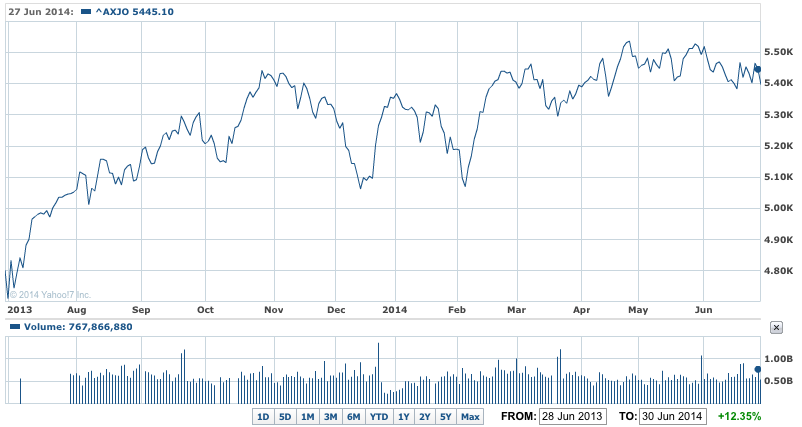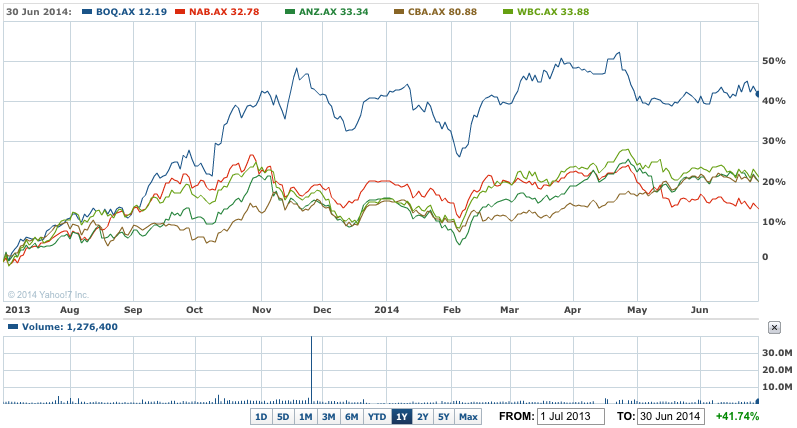Amid all the talk of double digital returns in the year to June 30 in Australia, the market analysts this morning have been reticent on how bad the performance has been in the first six months of 2014.
In fact our market has underperformed other markets quite noticeably so far in 2014, especially from around March when iron ore prices started falling.
They ended the six months down from just over $US134 a tonne at the end of last year to around $93 a tonne overnight – a fall of around 32%.
But that didn’t stop BHP Billiton (BHP) shares from rising 14.4% over the year (most of the rise came in the six months to December) or Rio Tinto (RIO), whose shares were up 13.3%.
Oil and gold have had a solid 2014, especially in June and the last quarter, thanks to the situation in Ukraine, and for the past month, Iraq.
The ASX 200, the key market measure, was up 12.35% in 2013-14, but only 0.8% of that happened from January 1 to June 30 this year as share price growth came to a halt.
XJO 1Y – Solid performance skewed to H1

The index closed 2013 at 5,352.2 and finished June on 5,395.7 – a rise of just 43.5 points, which is hardly encouraging at all. It closed at 4,802.59 points on June 28 last year.
That’s despite a solid rise in the price of the big four banks over the financial year, led by the Bank of Queensland (BOQ) whose shares jumped nearly 42%.
The Commonwealth Bank’s (CBA) shares rose nearly 17%, Westpac’s (WBC) shares were up 17.7%, the NAB’s shares rose 10.4% and the ANZ saw a 16.7% rise in its share price.
BOQ vs ANZ, CBA, NAB, WBC 1Y – Regional BOQ outperforms the majors

But the ASX 200 was little changed over the June quarter, closing at 5,394.8 points on March 31, and fell 1.8% over the month, from a close of 5,492.5 points on May 30.
Half that monthly fall occurred on the last day of June when the market dropped 49 points, or 0.9%.
So much for window dressing by investors on the last day of the month, quarter and financial year. It is forecast to start 2014-15 with a small gain at the start of trading this morning.
Wall Street saw a 21% rise in the S&P 500, the Nasdaq was up around 28% and the Dow rose 12.5%, which was very close to Australia.
But like Australia, the US markets saw much smaller gains in the six months to June 30 this year.
According to early estimates most balanced super funds will be up around 13% for the financial year – but as with the wider market, much of that gained happened in 2013, not this year.
Among the market sectors, technology rose 16% over the financial year (echoing the performance of Nasdaq), financials were up 15% (the big banks), consumer discretionary rose 13.6%, as did industrials.
Healthcare was up nearly 10% and consumer staples just 2% (and a big fall in the six months to June 30 this year).
The ASX 200 Index yesterday closed at 5395.7 points, while the All Ordinaries Index ended on 5382 points.
While the big banks and miners were higher over the 12 month period, June saw BHP off 3% and Fortescue down 1.4%.
Rio Tinto shares edged up a whole 0.01%, which is hardly worth anything.
The 32% fall in iron ore prices didn’t have the dramatic impact on the big miners iron the value of the Aussie dollar that many people had thought.
The Commonwealth Bank of Australia lost 0.9%, Westpac Banking Corporation fell 1.6%, National Australia Bank shed 2.1% to $32.78, and the ANZ fell 0.5%. Telstra’s shares lost 2.4%.
Retailers were hit by the budget’s impact on consumer confidence and spending. Woolworths shares fell 6.2%, and Wesfarmers (which owns Coles, Bunnings and other retail brands) fell 3.5%.
Even the market darling, CSL, saw its shares lose 5.7%, a fall helped by the rise in the value of the Aussie dollar back above 94 US cents in June (the dollar rose 2 US cents over 2013-14, or just over 2%).
Woodside fell 2.6%, despite a rise in US oil prices of around 2.6% for June and 3.6% for the quarter.
The price fall followed Shell’s exit from most of its Woodside holding.
Karoon Gas was the best performer in the ASX 200, up nearly 25%, thanks to the sale of gas assets to Origin for $800 million. But it was one of the worst performers over the financial year with a fall of 38%.
Paladin Energy was the worst – the shares slumped 24.4% in June (and 64% over the financial year), thanks to the continuing weakness in the uranium price and fears about the company’s longevity.
An interesting rise for June was the 17.1% jump in the price of GUD shares – it is one of the early June 30 balancing companies to report, so we will know if that rise is well informed.
A surprise fall came for recently listed travel insurance group, Covermore – its shares fell almost 20% in June. Over the year, the best performed stock in the ASX 200 was Northern Star Resources (NST) with a rise of 118%, the worst was Paladin Energy (PDN) with a fall of 64%.
But discount retailer, The Reject Shop (TRS) also stood out with a slide of 48% (with much of that happening in the six months to June), GrainCorp (GNC) shed 32% as grain prices fell and the bid from ADM of the US was blocked by the Federal Government.
Fairfax Media (FXJ) saw its shares rise nearly 88% (from a very low base) and News Corp shares rose 12% in the wake of the split a year ago.
Domino’s Pizza (DMP) stood out with a near 99% surge in its share price as its expansion into Japan paid off.
The most notable failures were engineering group, Forge Group which collapsed, in late 2013, and Nexus Energy which fell over last month after shareholders voted down the 2 cents a share offer from Seven Group Holdings.
Both were in the resources sector which remains the greatest single danger to the wider market.













